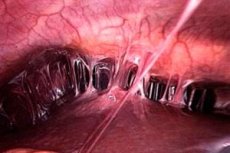Medical expert of the article
New publications
Inflammatory uterine disease
Last reviewed: 04.07.2025

All iLive content is medically reviewed or fact checked to ensure as much factual accuracy as possible.
We have strict sourcing guidelines and only link to reputable media sites, academic research institutions and, whenever possible, medically peer reviewed studies. Note that the numbers in parentheses ([1], [2], etc.) are clickable links to these studies.
If you feel that any of our content is inaccurate, out-of-date, or otherwise questionable, please select it and press Ctrl + Enter.

Inflammatory diseases of the uterus are infectious and inflammatory diseases of the upper female genital tract, including the uterus, fallopian tubes, and adjacent anatomical structures of the pelvis.
Infection and inflammation can spread to the abdominal organs, including the perirenal structures (Fitz-Hugh-Curtis syndrome).
Causes uterine inflammatory disease
Chlamydia trachomatis is the predominant pathogen of inflammatory diseases of the uterus. Other microorganisms are gonococci, vaginal gardnerella, hemophilic infection, Mycoplasma hominis, herpes simplex viruses 2, trichomonads, cytomegaloviruses and anaerobes (Peptococcus and Bacteroides). Laparoscopic studies have shown that in 30-40% of cases of infection the flora is polymicrobial.
Risk factors
The high-risk group includes women under 25 who have multiple sexual partners and do not use contraception. The development of inflammatory diseases of the uterus is facilitated by complicated abortions, childbirth, diagnostic curettage of the uterus, hysterosalpingography and other intrauterine interventions, especially those performed without taking into account the state of the vaginal microflora or with violation of the rules of asepsis and antisepsis.
Symptoms uterine inflammatory disease
Acute endometritis is characterized by a deterioration in the general condition, an increase in body temperature, sometimes chills, and tachycardia. Patients are bothered by pain in the lower abdomen and in the sacral region. Discharge from the genital tract is mucopurulent, cloudy, and often has an unpleasant odor. A vaginal examination reveals a moderately enlarged, painful uterus of soft consistency (subinvolution of the uterus is often detected after childbirth and abortions).
The main symptoms of chronic endometritis are menstrual cycle disorders - menorrhagia (hypermenorrhea, polymenorrhea), as well as bloody discharge after menstruation, aching pain in the lower abdomen, sacrum and lower back. Moderate enlargement and compaction of the uterus, limitation of its mobility (due to adhesions with neighboring organs - perimetritis) are observed.
Forms
Inflammatory diseases of the uterus include:
- endometritis - inflammation of the uterine mucosa;
- endometritis - inflammation of the mucous membrane and myometrium;
- panmetritis is an inflammatory process that affects all layers of the uterus.
Complications and consequences
Inflammatory diseases of the uterus can be complicated by the development of tubo-ovarian abscess, diffuse peritonitis and Fitz-Hugh-Curtis syndrome.
The main consequences are:
- Chronic pelvic pain. Occurs in approximately 25% of patients. This pain is thought to be related to cyclic menstrual changes, the presence of adhesions or hydrosalpinx.
- Infertility and impaired fertility. Infection and inflammation can lead to scarring and uterine adhesions.
- Ectopic pregnancy. The risk of developing an ectopic pregnancy increases by 15-50%.
Diagnostics uterine inflammatory disease
What do need to examine?
Differential diagnosis
Differential diagnosis includes appendicitis, cervicitis, urinary tract infections, endometriosis, adnexal tumors, and ectopic pregnancy.
Who to contact?
Treatment uterine inflammatory disease
In acute cases, patients are hospitalized. In hospital, cold is prescribed to the lower abdomen, and the source of infection is sanitized.
Washing the uterus with cold antiseptic solutions), conducting complex conservative therapy. After childbirth and abortions, it is necessary to use agents that reduce the uterus.
Treatment of chronic inflammatory diseases of the uterus usually includes the use of physiotherapy procedures, balneotherapy, and agents that increase the body's immunological reactivity. Ultrasound, electrophoresis of medicinal substances (iodine, zinc), therapeutic mud, paraffin, ozokerite, radon waters (baths, irrigation) are effective.


 [
[